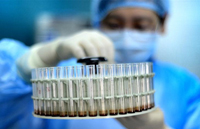Vehicle exhaust is biggest source of foul air: expert
By WANG HONGYI in Shanghai (China Daily) Updated: 2013-01-17 01:54Vehicle exhaust fumes have replaced industrial pollution as the biggest contributor to the worsening air quality in major Chinese cities, according to a top researcher.
Zhuang Guoshun has been studying trends in pollution levels since 1998, and his team has collected 20,000 samples of atmospheric aerosol using monitoring stations.
"Over the past 20 to 30 years, we've seen a rise in manmade particulate matter in the atmosphere," he said. "Pollution from nitrogen oxide has increased sharply, mainly caused by car emissions."
PM2.5, particulate matter of 2.5 microns in diameter or smaller that can enter the lungs and blood stream, can be manmade or natural, and consists mainly of sulfate, nitrate, ammonium salt and organic carbon compounds.
Zhuang, a professor at Fudan University's Atmospheric Chemistry Research Center, said his team's monitoring stations found an increasing amount of sulfur dioxide flowing from the Xinjiang Uygur autonomous region to more industrial southeast coastal regions.
Sulfur dioxide is mainly produced by coal ash, a component of industrial dust that poses severe harm to human health. However, Zhuang said sulfur dioxide has been released at a slower rate in recent years owing to the desulfurization of fuels and relocation of polluting industries.
Instead, vehicle exhaust fumes are playing a larger part in changes to the Air Quality Index.
According to Zhuang's research, among manmade sources of PM2.5 in 2000, the ratio of industrial production to vehicle emissions was 7-to-3. But recent figures show the ratio is now 50-50.
In Shanghai, one of the most severely polluted cities, the number of registered vehicles surpassed 2.18 million by the end of last year, 50,000 more than in 2011, according to the Shanghai Information Center.
Over the weekend, heavy smog and haze enveloped Beijing and other parts of North China.
On Saturday, the density of PM2.5 climbed higher than 900 micrograms per cubic meter in several districts in the capital, a record high since the city began publishing the data in early 2012, the Beijing Municipal Environmental Monitoring Center said.
Of the 74 cities with systems equipped to monitor levels of PM2.5, 33 recorded levels above 300 micrograms per cubic meter.
According to the World Health Organization, the safe daily level is 25.
"The government needs to put more effort into developing public transport, which saves energy and is good for the environment," said Zhuang, who commutes to work on public transport every day.
"Our country's development aims to provide a better life for people," he said. "But if the current development doesn't bring results, the government should seriously think it over."
Yang Xin, a professor of environment science and engineering, also called on people to change their ideas about development.
"We have long been focusing on economic development, but we should figure out what kind of development we really need," said Yang.
- 129 telefraud suspects sent to mainland
- Unified work permit for foreigners on way
- Zika unlikely to spread on mainland, officials say
- Exchange rates shaping travel plans
- Mental compensation stipulated in miscarriages of justice
- Center set up in Hainan to study fishermen's guidebooks
- Beijing setting up G20's first center to aid corruption fight
- Government to improve 'weak links'
- Scientists developing multipurpose stratospheric airships
- Action plan aims to reduce new disability cases over next 5 years










